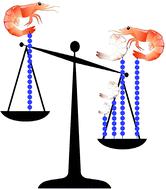当前位置:
X-MOL 学术
›
Green Chem.
›
论文详情
Our official English website, www.x-mol.net, welcomes your
feedback! (Note: you will need to create a separate account there.)
Farmed Jumbo shrimp molts: an ionic liquid strategy to increase chitin yield per animal while controlling molecular weight
Green Chemistry ( IF 9.3 ) Pub Date : 2020-08-26 , DOI: 10.1039/d0gc02216k Hannah B. Wineinger 1, 2, 3, 4 , Adrian Kelly 1, 2, 3, 4 , Julia L. Shamshina 1, 2, 3, 4, 5 , Robin D. Rogers 4, 5, 6, 7
Green Chemistry ( IF 9.3 ) Pub Date : 2020-08-26 , DOI: 10.1039/d0gc02216k Hannah B. Wineinger 1, 2, 3, 4 , Adrian Kelly 1, 2, 3, 4 , Julia L. Shamshina 1, 2, 3, 4, 5 , Robin D. Rogers 4, 5, 6, 7
Affiliation

|
In pursuit of bioplastics which require a controlled biopolymer molecular weight, consistency, and supply, we have examined the chitin in the molts of farm raised Hybrid (H1) Pacific whiteleg shrimp (Litopenaeus vannamei) by collecting the molts during the shrimp growth cycle, sorting by shrimp average body weight (ABW), and extracting the chitin from the molts using the ionic liquid (IL) 1-ethyl-3-methylimidazolium acetate ([C2mim][OAc]). The amount of available chitin in the molts increases with the age/size of the molting shrimp, 19% in juveniles to 22% in adults. As expected from the biology of molting, the chitin in the final shell peeled from the adult shrimp contained the most chitin (29%). It is neither easier nor harder to extract the chitin from molts or peels, and the extracted chitin was equivalent in purity and degree of acetylation with comparable extraction efficiency (67% for molts, 63% for peels). In addition, the weight average molecular weight (MW) of the chitin has the potential to be controlled by shrimp age/size. The MWs of the chitin in the smaller animals (5–10 and 10–20 g ABW) were comparable at ∼4–5 MDa, while the chitin obtained from the large adult molts (30–40+ g ABW) exhibited a significantly higher MW of 23 MDa. Thus, by collecting and using the shrimp molts, the industrial viability of chitin can be improved by providing both a larger amount of chitin per shrimp (an ca. 8-fold increase) and by providing the opportunity to extract chitin of a specific MW.
中文翻译:

养殖巨型虾蜕皮:一种离子液体策略,可在控制分子量的同时提高每只动物的几丁质产量
为了追求需要控制生物聚合物分子量,稠度和供应的生物塑料,我们通过在虾的生长周期中收集蜕皮,分选了养殖的杂交(H1)太平洋白腿虾(Litopenaeus vannamei)的蜕皮中的几丁质。虾平均体重(ABW),然后用离子液体(IL)1-乙基-3-甲基咪唑乙酸盐([C 2mim] [OAc])。蜕皮中甲壳质的可用甲壳质的数量随蜕皮虾的年龄/大小而增加,从少年的19%到成年的22%。正如蜕皮生物学所预期的那样,从成年虾上剥下来的最终壳中的几丁质中壳多糖含量最高(29%)。从蜕皮或果皮中提取几丁质既不容易也不困难,并且所提取的几丁质在纯度和乙酰化度方面相当,并且具有可比的提取效率(对于蜕皮而言为67%,对于果皮而言为63%)。另外,几丁质的重均分子量(M W)有可能受到虾龄/大小的控制。在中号w ^较小动物(5–10和10–20 g ABW)中的几丁质在4–5 MDa时具有可比性,而从大型成年蜕皮动物(30–40 + g ABW)获得的几丁质中M含量显着更高。W等于23 MDa。因此,通过收集和使用的虾蜕皮,几丁质的工业可行性可以通过提供两个较大的每虾(一个几丁质的量提高约8倍),并通过提供的机会,以一个特定的提取的几丁质中号W¯¯。
更新日期:2020-09-21
中文翻译:

养殖巨型虾蜕皮:一种离子液体策略,可在控制分子量的同时提高每只动物的几丁质产量
为了追求需要控制生物聚合物分子量,稠度和供应的生物塑料,我们通过在虾的生长周期中收集蜕皮,分选了养殖的杂交(H1)太平洋白腿虾(Litopenaeus vannamei)的蜕皮中的几丁质。虾平均体重(ABW),然后用离子液体(IL)1-乙基-3-甲基咪唑乙酸盐([C 2mim] [OAc])。蜕皮中甲壳质的可用甲壳质的数量随蜕皮虾的年龄/大小而增加,从少年的19%到成年的22%。正如蜕皮生物学所预期的那样,从成年虾上剥下来的最终壳中的几丁质中壳多糖含量最高(29%)。从蜕皮或果皮中提取几丁质既不容易也不困难,并且所提取的几丁质在纯度和乙酰化度方面相当,并且具有可比的提取效率(对于蜕皮而言为67%,对于果皮而言为63%)。另外,几丁质的重均分子量(M W)有可能受到虾龄/大小的控制。在中号w ^较小动物(5–10和10–20 g ABW)中的几丁质在4–5 MDa时具有可比性,而从大型成年蜕皮动物(30–40 + g ABW)获得的几丁质中M含量显着更高。W等于23 MDa。因此,通过收集和使用的虾蜕皮,几丁质的工业可行性可以通过提供两个较大的每虾(一个几丁质的量提高约8倍),并通过提供的机会,以一个特定的提取的几丁质中号W¯¯。











































 京公网安备 11010802027423号
京公网安备 11010802027423号